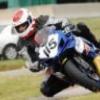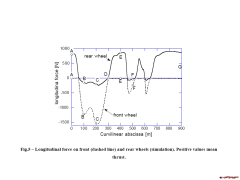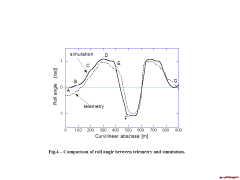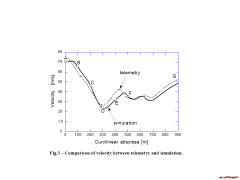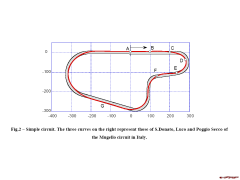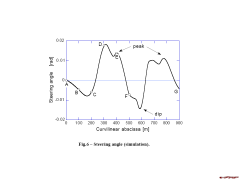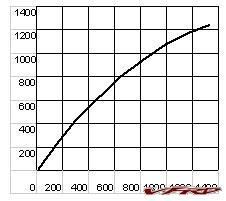-
Posts
66 -
Joined
-
Last visited
Content Type
Forums
Profiles
Gallery
Blogs
Downloads
Events
Everything posted by hlf
-
I really enjoyed the Cornerspin School when I attended almost 3 years ago. Hoping to do a lot more track days in 2011, I decided to look into Cornerspin again to refresh my riding skills. So, this past weekend, I headed back to school. Man, Cornerspin is just a blast! You get a chance to really practice riding at the limit of traction without risking serious injury. The small dirt bikes really give you great feedback, so you can really feel the effect of your riding position, throttle application, weight transfer, etc. Aaron Stevenson has continued to develop the curriculum, so the school is even better now than in the past. He's taken out some of the more flat-track oriented drills, and focused on feet-up road/track riding skills. You have more time working on lines, corner entry, braking, and getting on the gas early. The school's training tracks allow you to practice every conceivable road condition; decreasing radius turns, banked and off-camber, elevation changes, changing traction conditions, as well as combinations. This school will have you braking into turns, sliding both wheels, and power sliding out before you know it. You will not be surprised (or panic) when you lose traction. Not only will you gain valuable riding skills, but you will a fun time doing it. My cheeks hurt from smiling! Cornerspin is an educational amusement park! :cheerleader:
-
-
From the album: Optimal Manoeuvre
-
From the album: Optimal Manoeuvre
-
From the album: Optimal Manoeuvre
© ©vfdiscussion.com
-
I spent this past weekend attending Aaron Stevenson’s Cornerspin school; “Roadracing in the Dirt”. (Cornerspin School). This is a road racing school taught on dirt. Flat track and motard riding techniques are used with drills specifically applicable to road racing. Great road racers like Kenny Roberts, the Hayden brothers, Colin Edwards, Tony Elias, Sete Gibernau, Valentino Rossi, and Casey Stoner all learned riding on small dirt bikes and continue to train using dirt bikes. Using a small dirt bike really allows you to feel the how your body position, weight transfer, throttle and brake inputs, etc., effect the bike. Working with the relatively low traction of dirt allows you to slide the front and rear of the bike easily. Since these bikes weigh only about 150 lbs., everything you do on the bike is magnified, making it pretty obvious how you are impacting the motorcycle’s dynamics. The lower speeds minimize the pain of errors (well, this is mostly true, anyhow). Aaron Stevenson is the guy behind the Cornerspeed road racing school at Virginia International Raceway. His Cornerspin school is run at his facility just outside Salisbury, NC (about 30 miles north of Charlotte). On the facility, the first track you come to is a mini-flat track, with 50 foot straights connecting turns about 50 feet in diameter, on a clay like surface. Down the hill a bit is a football sized field just filled with intersecting tracks that twist and turn all over the place. There have to be at least 20 course variations in this maze. The tracks are typically about 10 feet wide. There are all sorts of turns and combinations; flat, banked, off-camber, constant radius, decreasing radius, increasing radius, with all sorts of elevation changes. The track had areas of sticky clay and very slippery dry dirt. Some of the turn combinations made you wonder how one could even get a bike around (yet, we were all able to do one-handed by the end of the school!). Arriving early Saturday morning, I met the other 6 students. Few of us had every ridden a dirt bike before. (The school is limited to 6 students on school bikes, plus 2 more students who must bring their own bike.) Aaron Stevenson is the chief instructor (road racing National Champion), assisted by Mike Dillion (former AMA pro flat tracker and road racer), Jean ? (flat tracker, road racer, and snowmobile racer), and Phillip Doyle (class A enduro rider, GNCC road racer). I rented off-road riding gear (man, are off-road boots heavy!!!), so all I had to bring were gloves and helmet. The school provides the dirt bikes (mostly Honda XR100’s, with a few Yamaha and Suzuki 125 4-strokes). The day’s first drills were braking drills; rear brake only, front brake only, then both. Sliding a little; then sliding a lot. On these small bikes you really feel how the chassis moves under front vs. rear braking. You also get to feel the front sliding/locking and how to modulate the pressure. Next up was the “Circle of Confusion”. This is a circular track about 30 feet in radius with some elevation and camber changes. We learned proper body position and how to properly place your inside foot down to avoid injury (really turn your toes toward the inside of the turn). We practiced sliding the rear wheel, feeling how the changes in elevation, camber, and dirt surface affected the amount of slide. On a dirt bike, you need to sit very far forward and on top of the bike, pushing the bike down under you. As a road bike rider, I’ve worked hard to get my upper body to the inside of a turn, so this was pretty awkward for me. But when you do it wrong on these dirt bikes, the bike can be very communicative: you find yourself on the ground in an instant! Like all the drills at Cornerspin, we rode the circle in both directions to make sure we got the drill both to the left and right. The instructors would demonstrate each drill, and then keep watching and correcting. The rest of the day was spent running through different track configurations, working on throttle control, braking, body position, relaxation, allowing the bike to move under you freely, etc. Aaron teaches you to hold the handlebars “screw driver” fashion. This means that you hold the bars with your forearm almost parallel to the bar, similar to the way you’d typically hold a screwdriver in your hand, instead of the common hand position where the forearm is almost perpendicular to the bar. Using the “screw driver” hold forces you to keep your elbows bent in a more relaxed position. You also have more finesse with the throttle. The instructors were constantly reminding us to “bend your elbows”, “move forward”, “get on the gas”, etc. They were great. A couple of things really struck me the first day. One was how much your body position can affect the traction on the front vs. the rear. Being 2 inches too far back will cause you to lose the front (and crash, which is pretty effective feedback!). The other was how critical it is to get on the gas quickly after braking into a turn. Some of the tracks we followed had incredibly tight turns, and the only way you could get around was to be off the brakes and on the gas quickly; coasting would invariably cause you to run wide. At the end of the day (close to 8 hours of riding), I was completely exhausted! I do a lot of cycling, so I was thinking I was in decent shape. Wrong! By mid-day I could hardly get my feet on the pegs, let alone hold my inside leg out straight, so had to do much of the afternoon riding feet on the pegs. It felt like I was wearing lead boots! I skipped the late afternoon free practice, since I was beat and my left forearm was about twice normal size due to swelling from one of my many falls. I left that day burnt out, with my arm in ice, wondering what I was thinking to be doing this. My only hope was Aaron’s words that the first day overwhelms you with information, but the light bulb comes on the 2nd day. Sunday morning, I woke up so sore that I needed to lift my feet with my hands to put on socks! Ice and Advil tamed the left arm swelling, so still not fully understanding why I was going back, I headed to the Cornerspin facility. And I’m glad I did! With no legs left, I decided I would just ride feet up the 2nd day. Fortunately, this was fine (even encouraged; this is a road racing school). We started on the mini-flat track, working on transferring weight to get the rear to hook up. We were practicing squaring off the double apex turns; braking hard to about the mid-point of the turn, turning hard to maximize the straight length, and shifting our weight on the pegs to get the spinning rear tire to hook up. It’s pretty cool to be power sliding out of the turn and have a small weight transfer give you more traction, enough to start lofting the front wheel. We spent the rest of the day trying to put it all together on a myriad of course configurations, with every imaginable type of turn and turn combination. Backing it in, and power sliding out. One really neat exercise was a braking drill where we approached a turn with a large mound of dirt in the “braking” zone. You could brake easily on the up-hill side of the mound, but you’d be too slow on the rest of the entrance to the turn. The fastest way was to brake lightly just before the crest, get off the brakes as the bike was unweighted over the top, and then get on the brakes again when the track flattened out just before making a tight turn. You really get to appreciate how elevation affects braking! We also ran this mound as a turn exit, so you accelerated out of a turn up the mound, and then had to modulate your throttle as you crested the mound and unweighted the bike. Definitely cool. The instructors were awesome to watch demonstrating techniques. There is so much to learn about bike handling and how precise one needs to be. Mike was particularly interesting talking about how fantastic flat tracking can be; the seemingly simple oval track, yet how hard it is to do it prefectly. He talked about how stoked he was to qualify 21st for his first AMA pro event; he was only 0.005 seconds off pole! Talk about small margins! After another 7-8 hours of riding, I was definitely finished. I could hardly lift by feet onto the pegs they were so tired. (I guess if you going to be stupid, you have to be tough!) I had to skip the free practice time. In any event, I had learned a lot about how bikes behave when you are near and over the traction limits. I had a ton of new information to integrate into my track and street riding. This was definitely a wonderful learning experience. The Cornerspin school is an incredible value, only $500 for 2 days including the bike! Sorry I don't have any photos, but there are plenty on the schools website. I now need to buy a small dirt bike to keep learning!! I just hope I recover from my current feeling that I've been run over by a bus!
-
From the album: Data
Vertical Load and Traction Notice in the graph of vertical load vs. traction force, as the vertical load on a tire increases, traction goes up, but the percentage of traction force decreases, effectively reducing the g?s a car can generate. For example, if this tire has 500 lbs. of vertical load on it, it can generate 660 lbs. of traction force, or 1.32 g?s (660 / 500 = 1.32). If the load were 800 lbs., the traction force would be 925 lbs., but only 1.16 g?s (925 / 800 = 1.16). This is the tire?s traction potential. As you will see, for any of several reasons, it will usually be less. This line can move around relative to the graph based on several conditions such as camber, ambient temperature, tire temperature and track surface condition, and obviously the type of tire. It will never be straight, however because the relationship is not linear.© ©vfdiscussion.com


